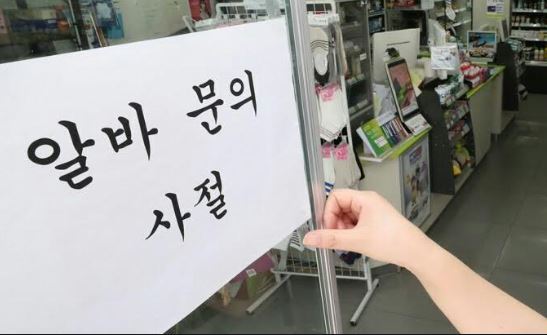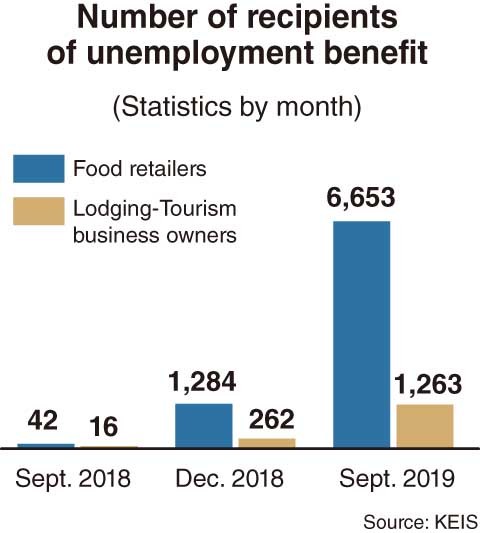[News Focus] Unemployment benefits snowball in food, lodging, tourism
By Kim Yon-sePublished : Oct. 31, 2019 - 17:36
SEJONG -- The volume of unemployment benefit payments to the jobless has nearly doubled over the past four years.
Though there were some people who exploited the state-led payout system via shady securing of beneficiary eligibility, data indicated that a growing number of people have been forced to leave their workplaces in the wake of an economic slowdown in recent years.
South Korea saw the monthly payouts of unemployment benefits reach 691.6 billion won ($592.8 million) in September 2019, compared to 458.9 billion won in September 2017 and 351 billion won in September 2015, according to the Korea Employment Information Service.
This showed a 97 percent jump in only four years, although there was a climb in lower-ceiling payments of unemployment benefits in proportion to the rise in the statutory minimum wage.
In addition, the number of monthly recipients increased from 350,959 to 450,607 for the corresponding four years. Compared to the figure for a year earlier in September 2018 (393,548), the number of recipients increased by more than 57,000.
Though there were some people who exploited the state-led payout system via shady securing of beneficiary eligibility, data indicated that a growing number of people have been forced to leave their workplaces in the wake of an economic slowdown in recent years.
South Korea saw the monthly payouts of unemployment benefits reach 691.6 billion won ($592.8 million) in September 2019, compared to 458.9 billion won in September 2017 and 351 billion won in September 2015, according to the Korea Employment Information Service.
This showed a 97 percent jump in only four years, although there was a climb in lower-ceiling payments of unemployment benefits in proportion to the rise in the statutory minimum wage.
In addition, the number of monthly recipients increased from 350,959 to 450,607 for the corresponding four years. Compared to the figure for a year earlier in September 2018 (393,548), the number of recipients increased by more than 57,000.

By region, Gyeonggi Province topped the list with 116,630 last month, followed by Seoul at 84,805, Busan with 35,110, South Gyeongsang Province at 31,630 and Incheon with 28,601. There were 2,274 recipients in the Sejong administrative-oriented city.
As a noteworthy point, the KEIS data showed that the number of recipients surged among Koreans engaged in services like food, lodging and tourism as business owners.
A year earlier in September 2018, only 42 food retailers were paid the unemployment allowance. But the number of recipients has rapidly climbed this year -- 2,884 in April, 3,469 in May, 4,099 in June, 5,272 in July, 6,032 in August and 6,653 in September.
The figure for lodging and tourism services also shot up to 1,263 in September 2019, compared to only 16 people a year earlier.
“Though the KEIS explains that there could be difference in figures between net recipients and redundancy-included recipients in statistics, it is evident that the small-sized restaurant and lodging-tourism sectors represented a sharp contrast to other major jobs,” said a research analyst in Seoul.
He attributed their increase in the portion of payout recipients to en masse closure of operations among the self-employed and micro-business owners.

A large percentage of the self-employed were engaging in the three retail sectors, which have been hit by both a sagging economy and tough burden for labor costs in the wake of drastic hike in the minimum wage in 2018 and 2019.
Based on monthly payment for workers, the minimum wage climbed from 1.35 million won in 2017 to 1.74 million won in 2019.
According to a release from the Ministry of Employment and Labor, the average recipient was paid 1.18 million won a month in 2017. That average monthly payment surged to 1.51 million won in 2019.
On a yearly cumulative basis, the payouts for the jobless reached a record high of 6.4 trillion won for 1.33 million recipients in 2018, continuously topping the former highs of 5 trillion won in 2017 and 4.6 trillion won in 2016.
As it is stood at 2.4 trillion won in 2008, the nation’s unemployment benefit payment jumped more than 160 percent in a decade. And the yearly figure for 2019 is estimated to exceed 8 trillion won if it maintains its current pace.
As for last month’s payouts by generation, recipients in their 50s accounted for the largest proportion at 26.5 percent, trailed by those in their 60s with 22.6 percent, those in their 40s with 19.5 percent, those in their 30s with 19 percent and those in their 20s at 11.5 percent.
Men slightly outnumbered women among benefit claimants in the month, accounting for 50.1 percent of the total.
By Kim Yon-se (kys@heraldcorp.com)





![[From the Scene] Monks, Buddhists hail return of remains of Buddhas](http://res.heraldm.com/phpwas/restmb_idxmake.php?idx=644&simg=/content/image/2024/04/19/20240419050617_0.jpg&u=20240419175937)





![[Graphic News] French bulldog most popular breed in US, Maltese most popular in Korea](http://res.heraldm.com/phpwas/restmb_idxmake.php?idx=644&simg=/content/image/2024/04/18/20240418050864_0.gif&u=)


![[From the Scene] Monks, Buddhists hail return of remains of Buddhas](http://res.heraldm.com/phpwas/restmb_idxmake.php?idx=652&simg=/content/image/2024/04/19/20240419050617_0.jpg&u=20240419175937)

![[KH Explains] Hyundai's full hybrid edge to pay off amid slow transition to pure EVs](http://res.heraldm.com/phpwas/restmb_idxmake.php?idx=652&simg=/content/image/2024/04/18/20240418050645_0.jpg&u=20240419100350)

![[Today’s K-pop] Illit drops debut single remix](http://res.heraldm.com/phpwas/restmb_idxmake.php?idx=642&simg=/content/image/2024/04/19/20240419050612_0.jpg&u=)